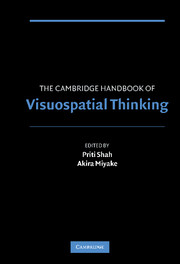Book contents
- The Cambridge Handbook of Visuospatial Thinking
- The Cambridge Handbook of Visuospatial Thinking
- Copyright page
- Contents
- List of Contributors
- Preface
- Acknowledgments
- 1 Functional Significance of Visuospatial Representations
- 2 Visuospatial Images
- 3 Disorders of Visuospatial WorkingMemory
- 4 Individual Differences in Spatial Abilities
- 5 Sex Differencesin Visuospatial Abilities
- 6 Development of Spatial Competence
- 7 Navigation
- 8 Mapping the Understanding of Understanding Maps
- 9 Spatial Situation Models
- 10 Design Applications of Visual Spatial Thinking
- 11 The Comprehension of Quantitative Information in Graphical Displays
- 12 Multimedia Learning: GuidingVisuospatial Thinking with Instructional Animation
- Author Index
- Subject Index
7 - Navigation
Published online by Cambridge University Press: 05 June 2012
- The Cambridge Handbook of Visuospatial Thinking
- The Cambridge Handbook of Visuospatial Thinking
- Copyright page
- Contents
- List of Contributors
- Preface
- Acknowledgments
- 1 Functional Significance of Visuospatial Representations
- 2 Visuospatial Images
- 3 Disorders of Visuospatial WorkingMemory
- 4 Individual Differences in Spatial Abilities
- 5 Sex Differencesin Visuospatial Abilities
- 6 Development of Spatial Competence
- 7 Navigation
- 8 Mapping the Understanding of Understanding Maps
- 9 Spatial Situation Models
- 10 Design Applications of Visual Spatial Thinking
- 11 The Comprehension of Quantitative Information in Graphical Displays
- 12 Multimedia Learning: GuidingVisuospatial Thinking with Instructional Animation
- Author Index
- Subject Index
Summary
Navigation is coordinated and goal-directed movement through the environment by organisms or intelligent machines. It involves both planning and execution of movements. It may be understood to include the two components of locomotion and wayfinding. Locomotion is body movement coordinated to the local surrounds; wayfinding is planning and decision making coordinated to the distal as well as local surrounds. Several sensory modalities provide information for navigating, and a variety of cognitive systems are involved in processing information from the senses and from memory. Animals update their orientation – their knowledge of location and heading – as they move about. Combinations of landmark-based and dead-reckoning processes are used to update. Humans also use symbolic representations to maintain orientation, including language and cartographic maps. Factors have been identified that make orientation easier in some environments than others. Neuroscience has pointed to the role of certain brain structures in the maintenance of orientation and has uncovered evidence for neurons that fire preferentially in response to an animal’s location or heading. Artificial intelligence researchers develop computer models that test theories of navigational cognition or just create competent robots.
- Type
- Chapter
- Information
- The Cambridge Handbook of Visuospatial Thinking , pp. 257 - 294Publisher: Cambridge University PressPrint publication year: 2005
- 209
- Cited by



